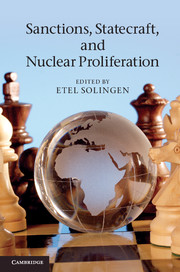Book contents
- Frontmatter
- Contents
- Figures
- Tables
- Contributors
- Preface and acknowledgments
- Part I Anatomy of inducements
- Part II Competing perspectives
- 5 An analytically eclectic approach to sanctions and nonproliferation
- 6 Threats for peace?
- Part III Reassessing the record: focused perspectives
- 7 Influencing Iran’s decisions on the nuclear program
- 8 Engaging North Korea
- 9 Contrasting causal mechanisms
- Part IV Conclusions: understanding causal mechanisms and policy implications
- References
- Index
9 - Contrasting causal mechanisms
Iraq and Libya
Published online by Cambridge University Press: 05 June 2012
- Frontmatter
- Contents
- Figures
- Tables
- Contributors
- Preface and acknowledgments
- Part I Anatomy of inducements
- Part II Competing perspectives
- 5 An analytically eclectic approach to sanctions and nonproliferation
- 6 Threats for peace?
- Part III Reassessing the record: focused perspectives
- 7 Influencing Iran’s decisions on the nuclear program
- 8 Engaging North Korea
- 9 Contrasting causal mechanisms
- Part IV Conclusions: understanding causal mechanisms and policy implications
- References
- Index
Summary
Introduction
In March 2003, the United States led an international military coalition to disarm Iraq of suspected weapons of mass destruction (WMD). While Saddam Hussein largely ended Iraq’s WMD programs in 1991, Iraq’s resistance to certain UN inspections and other measures led many to believe that it maintained WMD stockpiles and was reconstituting a nuclear weapons program. Nine months after the invasion of Iraq, Libya’s leadership announced that it was “of its own free will” dismantling all of its WMD programs and would abide by the Nuclear Non-Proliferation Treaty. After thirty years of trying to acquire nuclear weapons, Muammar Qaddafi changed Libya’s course to one of “building a new world void of WMD and void of all types of terrorism.”
For decades, both Saddam’s Iraq and Qaddafi’s Libya had sought nuclear weapons and found their countries the targets of unilateral and multilateral inducements. US-led economic sanctions and military threats were often employed as a coercive policy tool aimed in part at rolling back the illicit weapons programs. The intention was to punish or deny benefits to these leaders, for instance, by weakening their ruling coalitions and undermining their political and economic hold on power. Potential benefits associated with political and economic reintegration with the Western-oriented global system and assurances of regime survival, of varying credibility, went hand-in-hand with the sanctions. The United States and other countries offered these positive inducements as rewards for the leaders and their constituents interested in normalizing relations with the West, on condition that they would verifiably forgo WMD.
- Type
- Chapter
- Information
- Sanctions, Statecraft, and Nuclear Proliferation , pp. 261 - 294Publisher: Cambridge University PressPrint publication year: 2012
- 3
- Cited by



